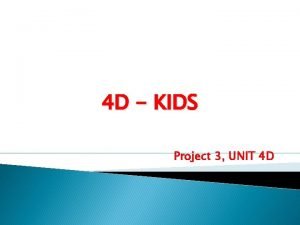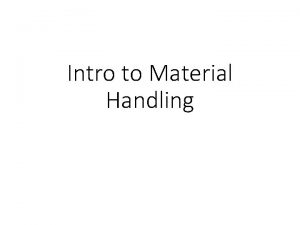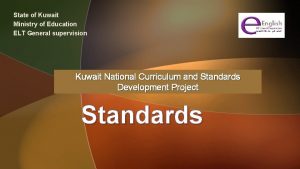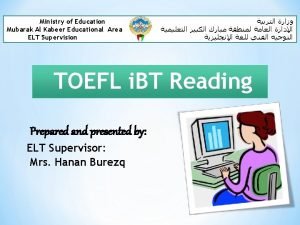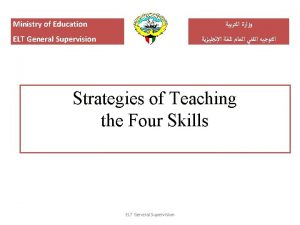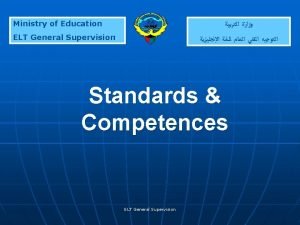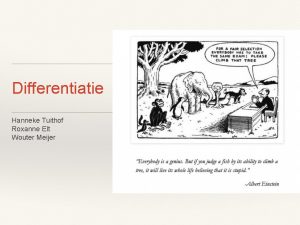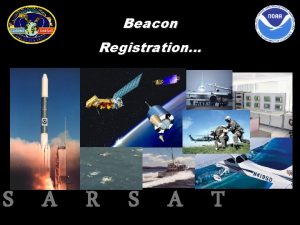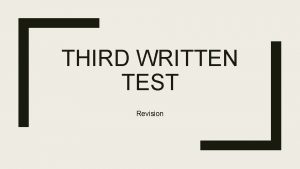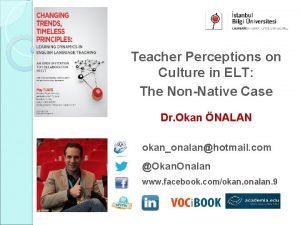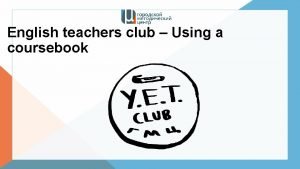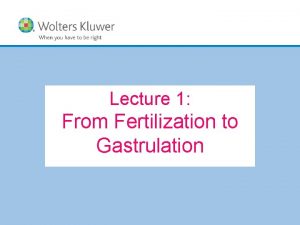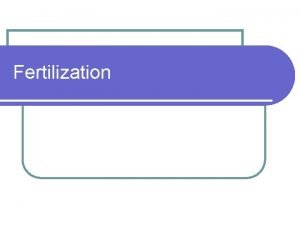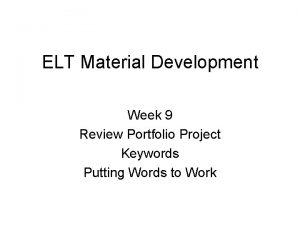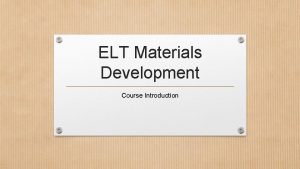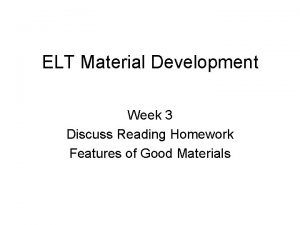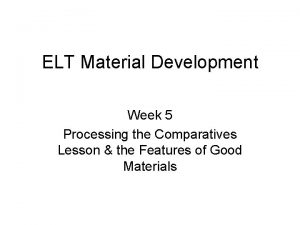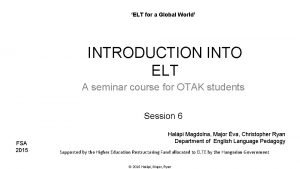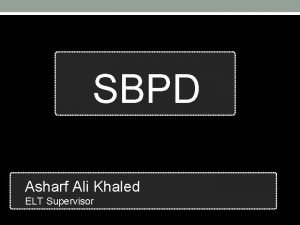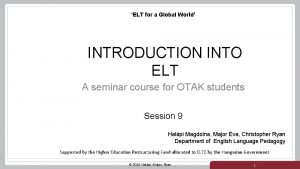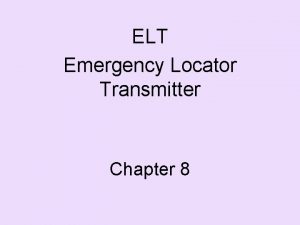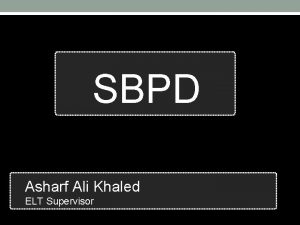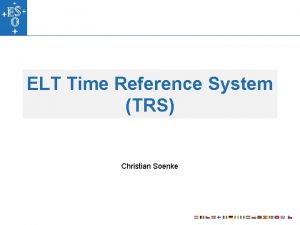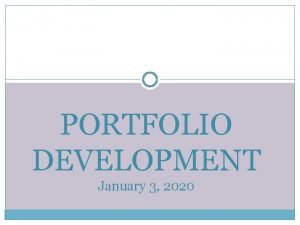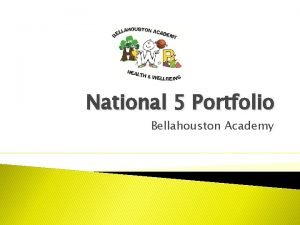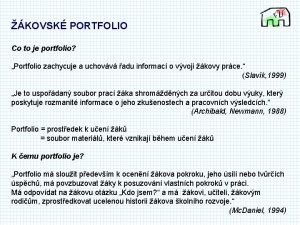ELT Material Development Week 8 Intro Portfolio Project


























- Slides: 26

ELT Material Development Week 8 Intro Portfolio Project Text-based tasks Sample Lesson & Processing

Portfolio Project • The following materials needed to be created to supplement the textbook: – – Authentic listening and reading materials & activities Vocabulary building materials Inductive teaching and discovery learning materials Personalized, contextualized and freer communicative practice activities/games – Task-based learning and performance assessment activities

Authentic Reading and Listening Materials & Activities • Find age appropriate and topic appropriate materials from popular culture such as – Popular music – News and current events – Movies and television – Comic books – Literature – Magazines and websites

Vocabulary Building Materials • The vocabulary you choose to build will come from: – The textbook – The tasks and activities that your Ss need to do – The authentic listening and/or reading materials that you supplement into the unit

Inductive Teaching & Discovery Learning Materials • Like vocabulary new grammatical knowledge needs to be integrated into existing knowledge • Discovery learning materials allow Ss to discover the meaning, the structure and the use of grammatical forms • Puzzles, guided discovery activities, sentence analysis and comparison activities and classification and categorization activities

Communicative Activities and Games • • • Roles plays Find some one who activities Mingle activities Open ended Q&A games Drama activities and games

Task-based learning activities • Structured debates & consensus building tasks • Problem and solution activities • Creative projects such as fractured fairy tales or re-writting the end of a popular TV drama or movie • Posters and presentations

Homework Discussion • Share your authentic listening or reading materials • Share the chapter or unit that those authentic materials will supplement • Describe why those materials are appropriate for the chapter/unit and your target learners • Describe the activities that you will do with those materials

Homework for Next Week • Find the keywords and key expressions in the chapter or unit • Find the keywords of key expressions in the authentic listening or reading materials • Brainstorm a list of possible vocabulary activities

Using Text-based Tasks • How are reading and listening/watching different from each other? Why is it important in material and task design to recognize these differences? • Why do we want to encourage learners to read or listen to a text multiple times?

Selection Criteria for Texts • Look at the texts on page 143 and 145 and discuss these texts in terms of: – Topic – Exploitability – Length/chunk-ability – Linguistic complexity – Accessibility

Selection Criteria for Texts • Look your authentic materials and discuss them in terms of – Topic – Exploitability – Length/chunk-ability – Linguistic complexity – Accessibility

Using Text-based Tasks • When using text-based materials, what comes first comprehension or communicative tasks? Why? • Is there a sequence of activities that we should be aware of when using text-based materials? What is that sequence? • In that sequence where do the communicative activities come? Why?

Using Text-based Tasks • What are some common patterns found in texts? • What are some common text-based activities and tasks?

Common Patterns • Situation-Problem-Solution-Evaluation • Sequential • General to Specific – Topic-Elaboration – Main fact - Supporting details • Hypothesis-Evidence-Conclusion

Common Text-based Activities and Tasks • • • Prediction tasks Jumbles Restoration tasks Jigsaws Comparison tasks Memory Challenge tasks (when used, Ss should have additional exposure to the text after the memory challenge is done)

Texts, Tasks and Lesson Plans • What is the receptive skill framework? • What is the task-based learning framework? • When doing text-based tasks, how do we put the two together? Pre-During-Post Pre Task – Language Focus

Putting Words to Work • Integrate into existing knowledge by… – Creating associations and links through decision making activities • What are some common decision making activities?

Decision Making Activities • • • Identifying Selecting Matching Sorting Ranking and/or sequencing

Identifying Activities 1. Underline all the phrasal verbs in the text 2. Circle all the comparative adjectives

Identifying Activities Circle what you hear.

Identifying Activities • Word searches are FORM focused activities rather than a MEANING focused activities. • Word searches help Ss with letter recognition and spelling but not meaning and use

Selecting Activities Techniques • Provide Ss with a word bank or word banks • Ask Ss to select the word or words to complete some kind of purpose such as description or which word doesn’t or does belong trap cat gap zap

Matching Activities • Can involve – Pictures – Definitions – Synonyms – Antonyms – Collocations

Sorting Activity Techniques • Involves categories such as positive and negative • Allows for the accommodation of visual, tactile and kinesthetic learners

Ranking and Sequencing • These activities require students to put words into some kind of logical order in terms of – Time – Distance – Usefulness – Difficulty – Interest – Etc…
 Week by week plans for documenting children's development
Week by week plans for documenting children's development Project 3 unit 4
Project 3 unit 4 Intro to material handling
Intro to material handling What is a portfolio
What is a portfolio General elt
General elt Repakelt
Repakelt Mubarak al-kabeer educational zone
Mubarak al-kabeer educational zone التوجيه الفني للغة الانجليزية
التوجيه الفني للغة الانجليزية Elt general supervision kuwait
Elt general supervision kuwait The direct method is
The direct method is Elt supervision
Elt supervision Roxanne elt
Roxanne elt Noaa epirb registration
Noaa epirb registration Function words examples
Function words examples Elt supervision
Elt supervision Esap
Esap Will + infinitive
Will + infinitive Okan elt
Okan elt English teachers club
English teachers club Datum shift
Datum shift Idle time meaning in cost accounting
Idle time meaning in cost accounting Cultural relativism meaning
Cultural relativism meaning The knowledge language values customs and material objects
The knowledge language values customs and material objects Examples of non material culture
Examples of non material culture Materials that are useful and harmful
Materials that are useful and harmful First week of development
First week of development Phase of fertilization
Phase of fertilization

